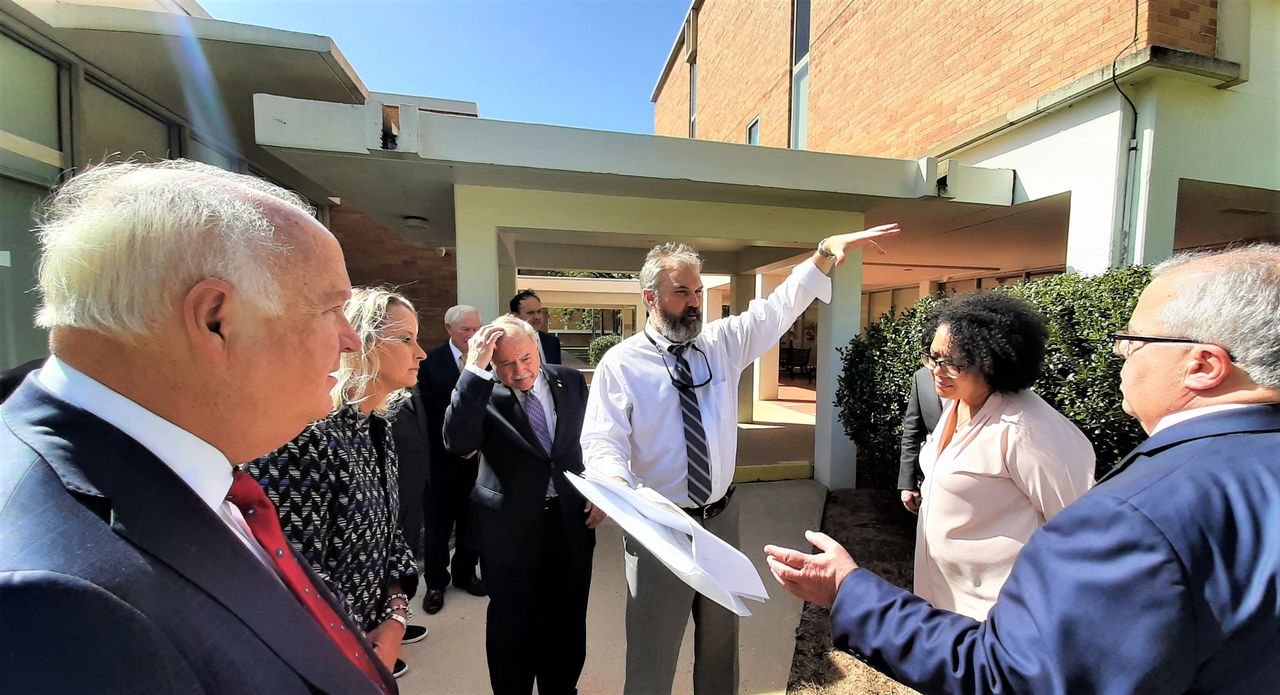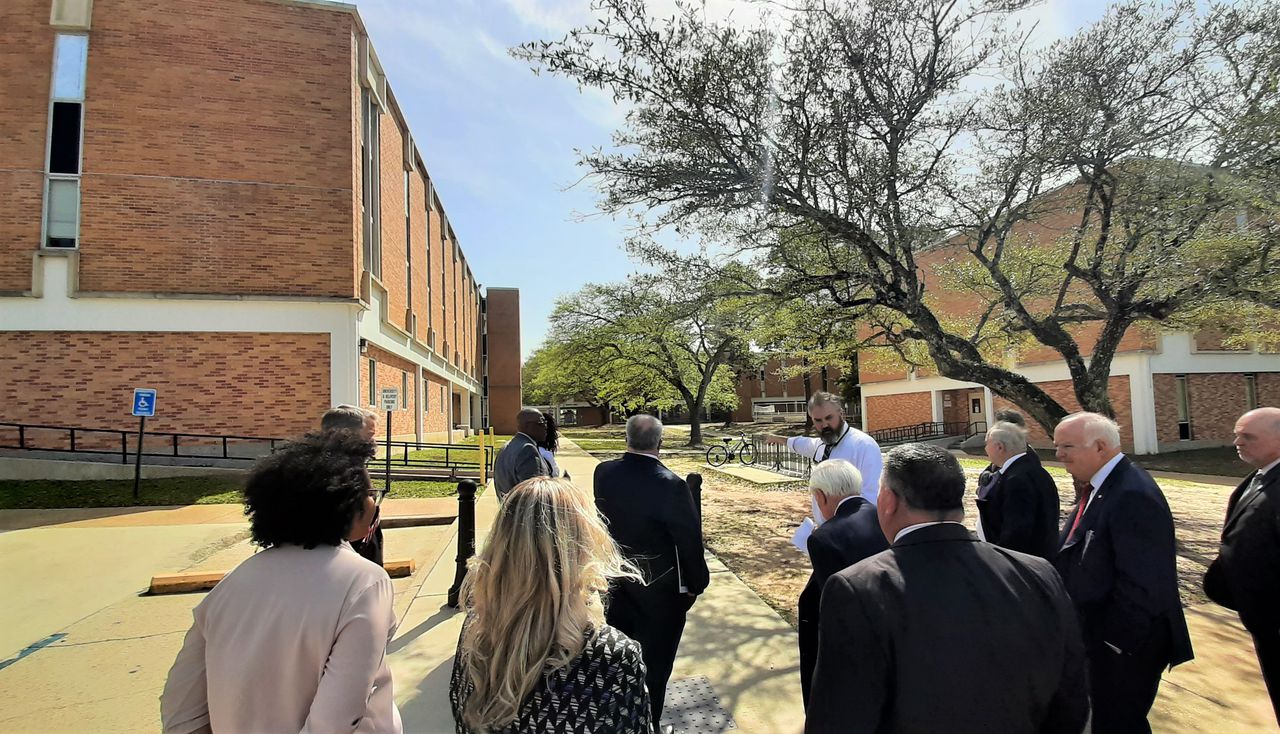USA gets first look at footprint of new medical school building
The University of South Alabama’s new medical school facilities will bring a highly visible transformation to South’s campus, judging from a first look at the site where the new buildings will rise.
Following a board of trustees meeting on Friday, a JagTran bus ferried some of the university’s trustees and top administrators to a corner of campus where yellow tape staked out the perimeter of the new construction, to help onlookers visualize the scope of the project. Buck Kelley, who manages facilities and construction projects for the University, described what’s coming.
It’s big, and it’ll involve the demolition of two of the campus’ oldest buildings.
Buck Kelley, who oversees construction for the University of South Alabama, describes the new medical school facility that will be built on South’s campus over the next few years. Alpha Hall East, at left, and Alpha Hall South, in the background, will be torn down.Lawrence Specker | [email protected]
Back in January 2022, leaders such as Dr. John V. Marymont, vice president for medical affairs and dean of USA’s College of Medicine, and Owen Bailey, CEO and senior associate vice president for medical affairs at USA Health, envisioned a $120 million project that would renovate and expand the existing medical school facility.
That plan has changed. Marymont and USA President Jo Bonner said one concern was that renovations would be too disruptive for ongoing medical research. Another was that new construction would give more bang for the buck than trying renovate one that wasn’t built to serve modern concepts of how a medical school should function.
“It began to make all the sense in the world,” said Bonner. “It will be a little bit more expensive to do it, but it’s going to be done right.”
This summer, the building known as Alpha Hall East will be torn down. That work will be visible from University Boulevard: Alpha East parallels the road near the northwestern corner of the main campus. It’s a bit southeast of the much newer, bigger Health Sciences Building that houses USA’s College of Nursing.
Toward the end of 2023, Alpha Hall South, another low rectangular building that sits perpendicular to Alpha East, will come down. After that, the new home of the Frederick J. Whiddon College of Medicine will begin to rise. An L-shaped building with a four-story education wing and a five-story research wing, it’ll sit a bit closer to University Boulevard, lining up with the Health Sciences Building. The goal is for it to open in 2026. Eventually the Medical Sciences Building that serves as the current home of the College of Medicine will be torn down, leaving some prime real estate for unspecified future construction.

Project maps show the current layout of buildings where the University of South Alabama’s new medical school will rise (top) and how the area will look after the project (bottom), University Boulevard is at right.USA/Eskew Dumez Ripple
Moving the college of medicine closer to the Health Sciences Building and the College of Nursing will create “a whole medical district,” Marymont said.
As the vision has grown, so has the price tag. Marymont said he expects the project will push close to $200 million. The good news is that a substantial portion has already been secured.
“Governor Ivey, and her $50 million commitment, The USA Foundation, Maxey Roberts and John McMillan, their group [committed] $30 million, and then Sen. [Richard] Shelby came in with $60 million from the federal government,” said Marymont. “That really, really changed the game from trying to renovate an out-of-date, end-of-life building into something very, very special for the state of Alabama.” With $140 million in hand, the university is developing a fundraising campaign to raise the rest, he said.
Marymont said the expanded facilities will allow USA to increase the size of its graduating medical school classes from 80 now to 100. He doesn’t want that to happen too fast and he doesn’t want the school to outgrow its sense of family, he said, but the growth will help the college’s mission to serve the state.
Marymont said years of work had gone into detailing the program’s needs and turning those into the exact specifications of a new building, so that the building could be approved.
“This programming has gone on for three years,” he said. “You don’t get the money and then start the process. I knew we needed a new school when I came here six and a half years ago.” Planning began under President Tony Waldrop, Bonner’s predecessor.

Buck Kelley, who oversees construction for the University of South Alabama, describes the new medical school facility that will be built on South’s campus over the next few years. The buildings at right and left will be torn down to make way for new construction. At left is USA President Jo Bonner; at right is Dr. John V. Marymont, vice president for medical affairs and dean of USA’s College of Medicine.Lawrence Specker | [email protected]
“This is really for the state of Alabama,” said Marymont. “We put our graduates throughout the state.”
Among medical schools, Marymont said, USA is in the 85th percentile in terms of how many of its new doctors go on to work in the same state where they were educated. It’s over the 90th percentile in terms of how many of its graduates go into rural areas and the 100th percentile for graduates working in underserved areas, he said.
“So we send our students, high-quality students … to the state of Alabama,” he said. “We meet our mission. This is what it’s really about.”
